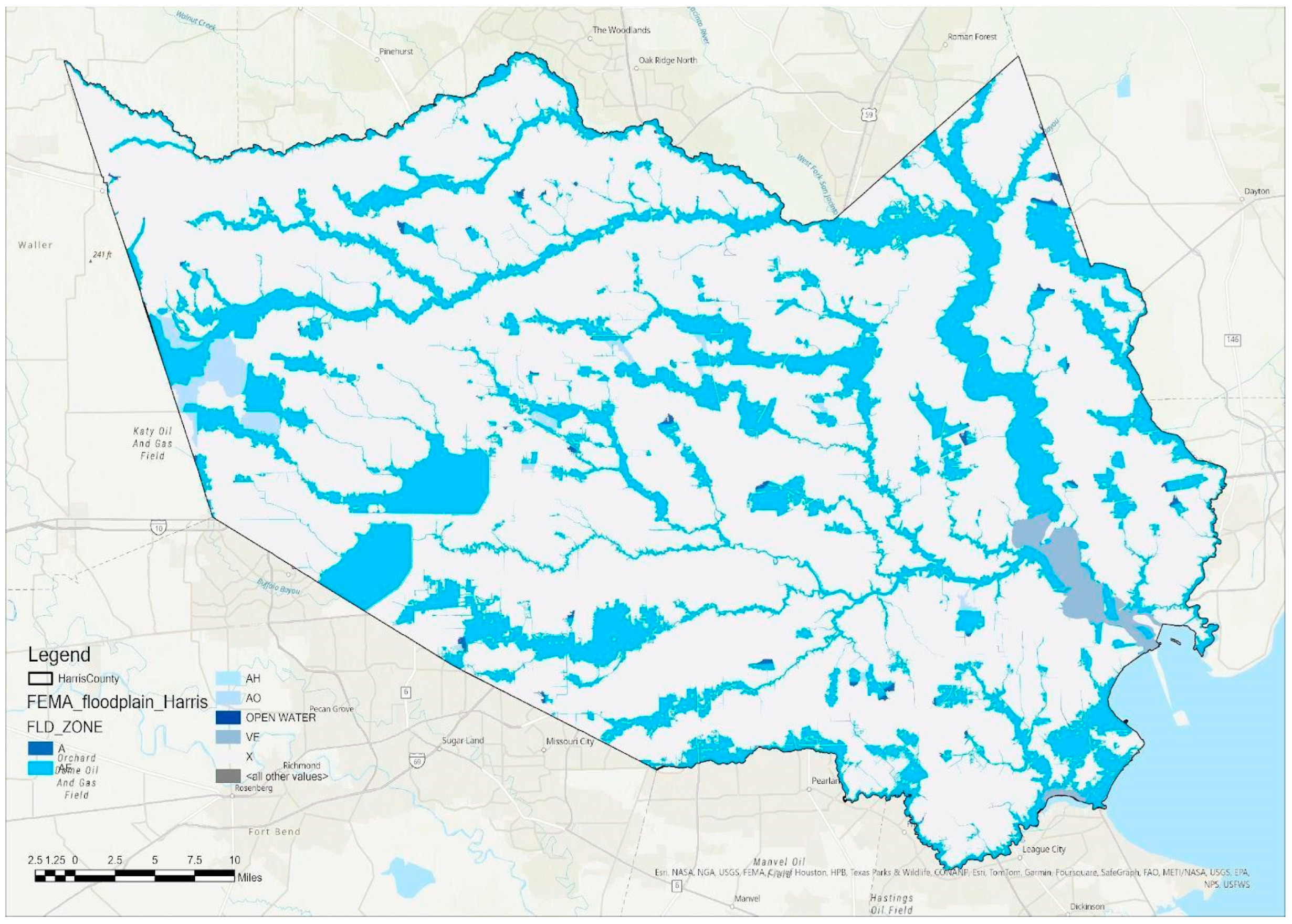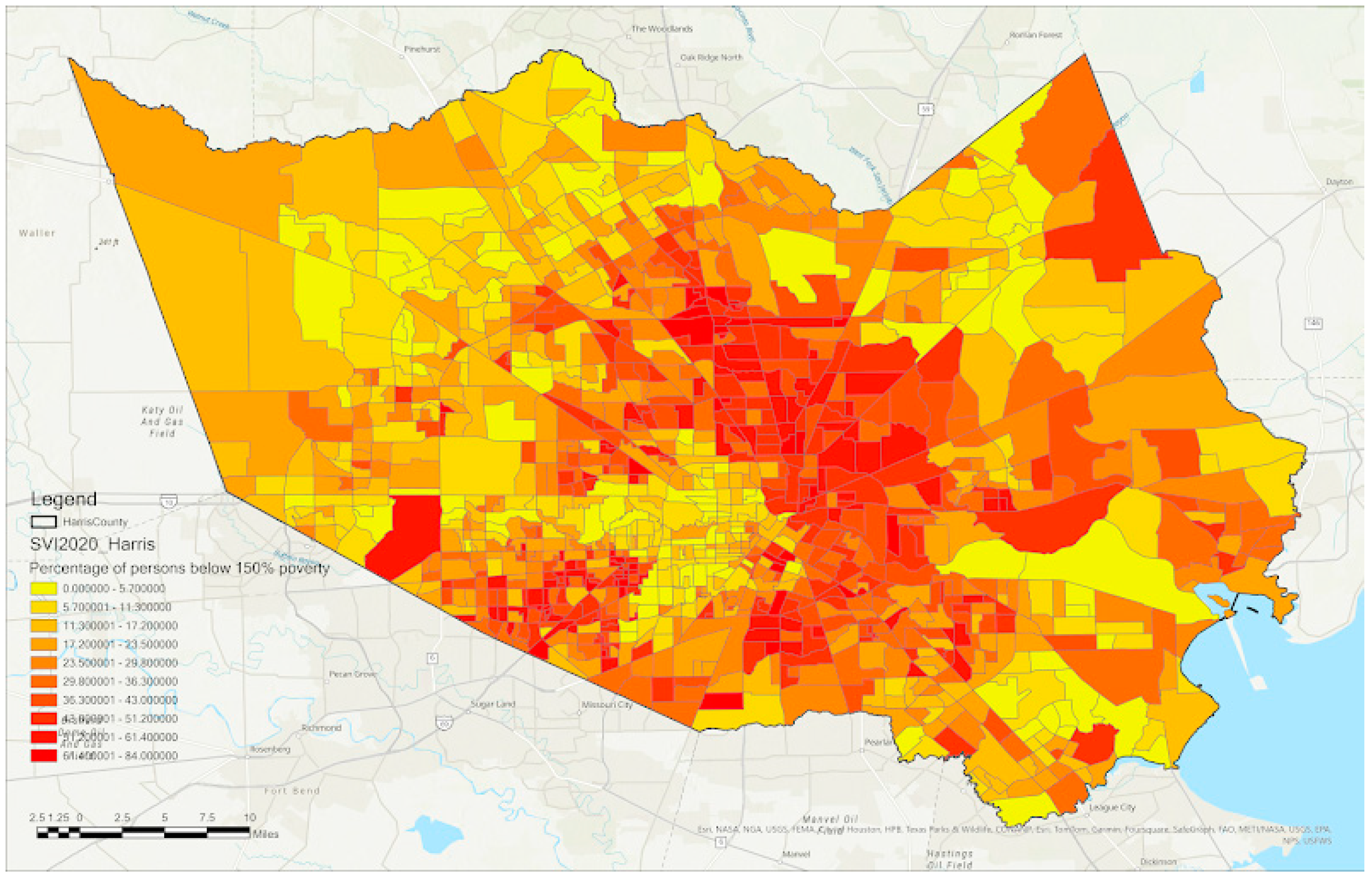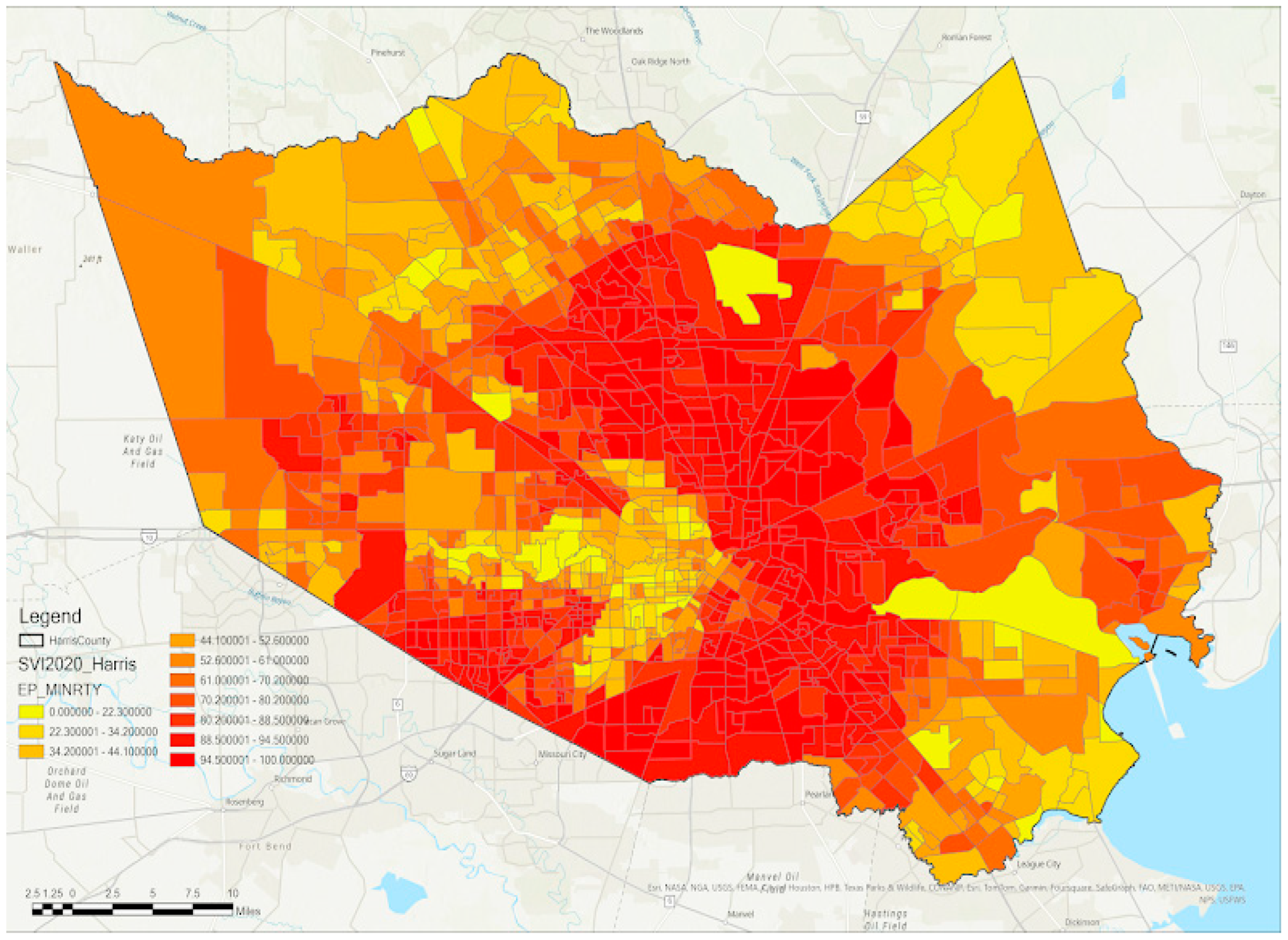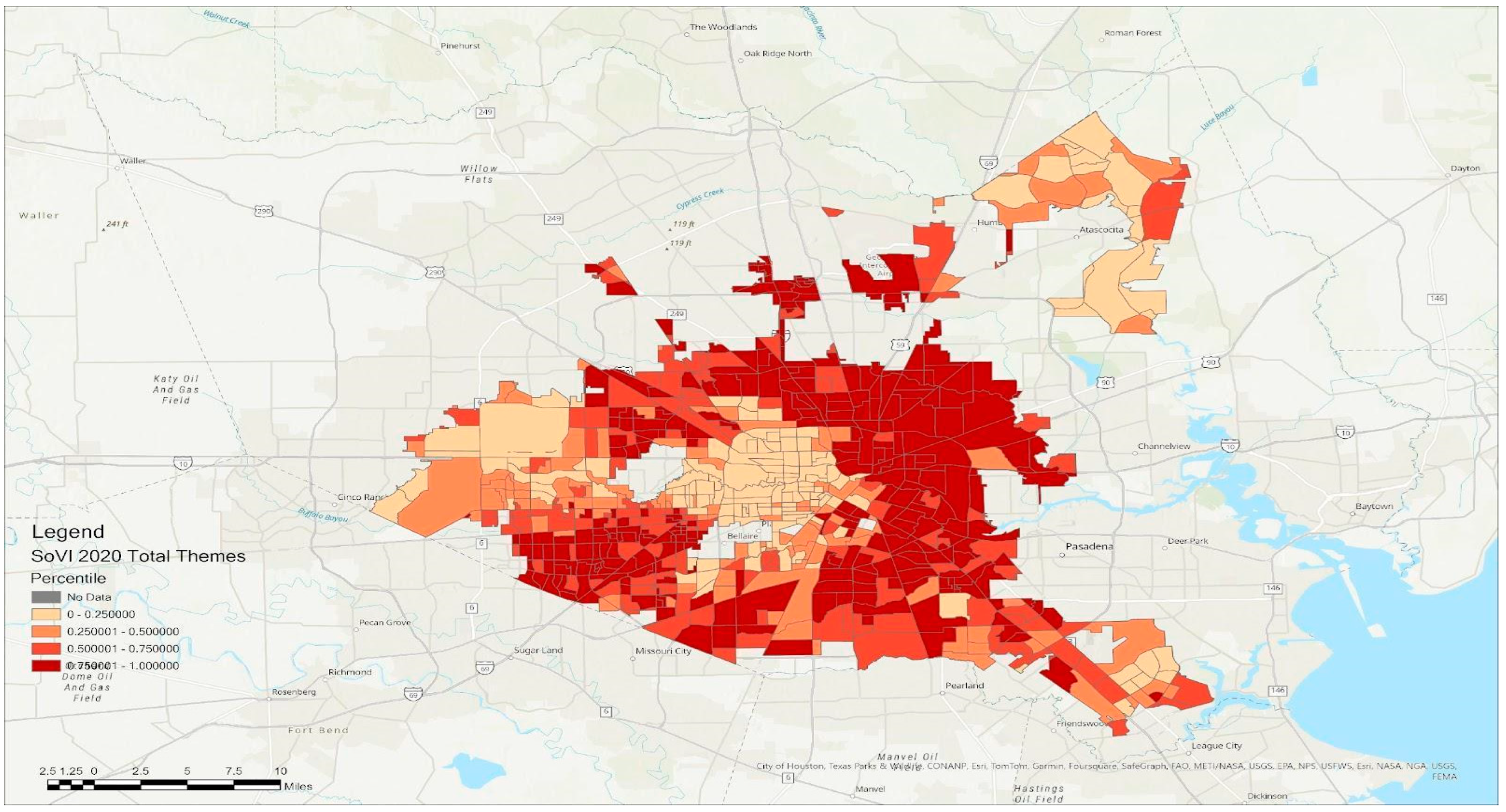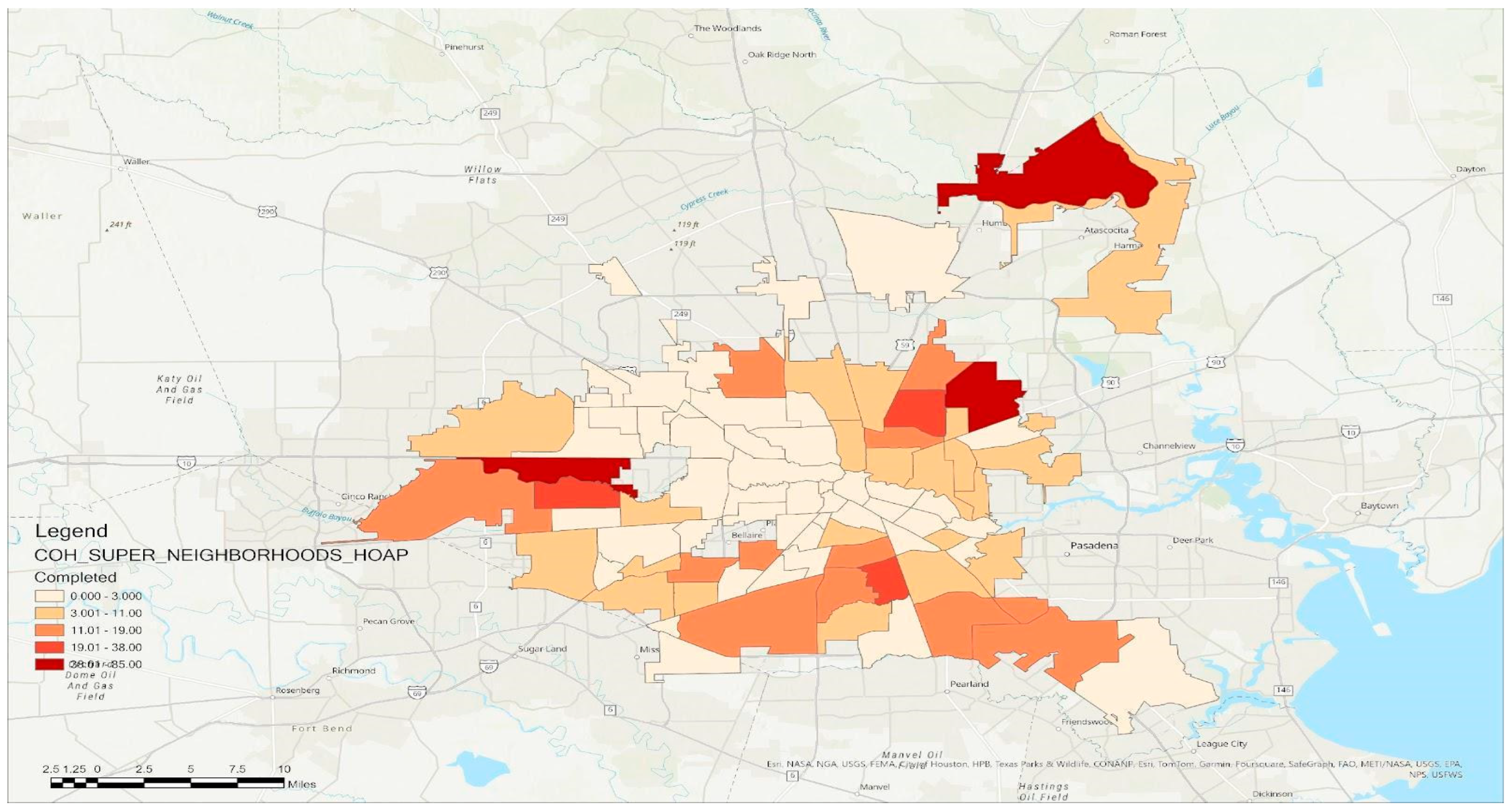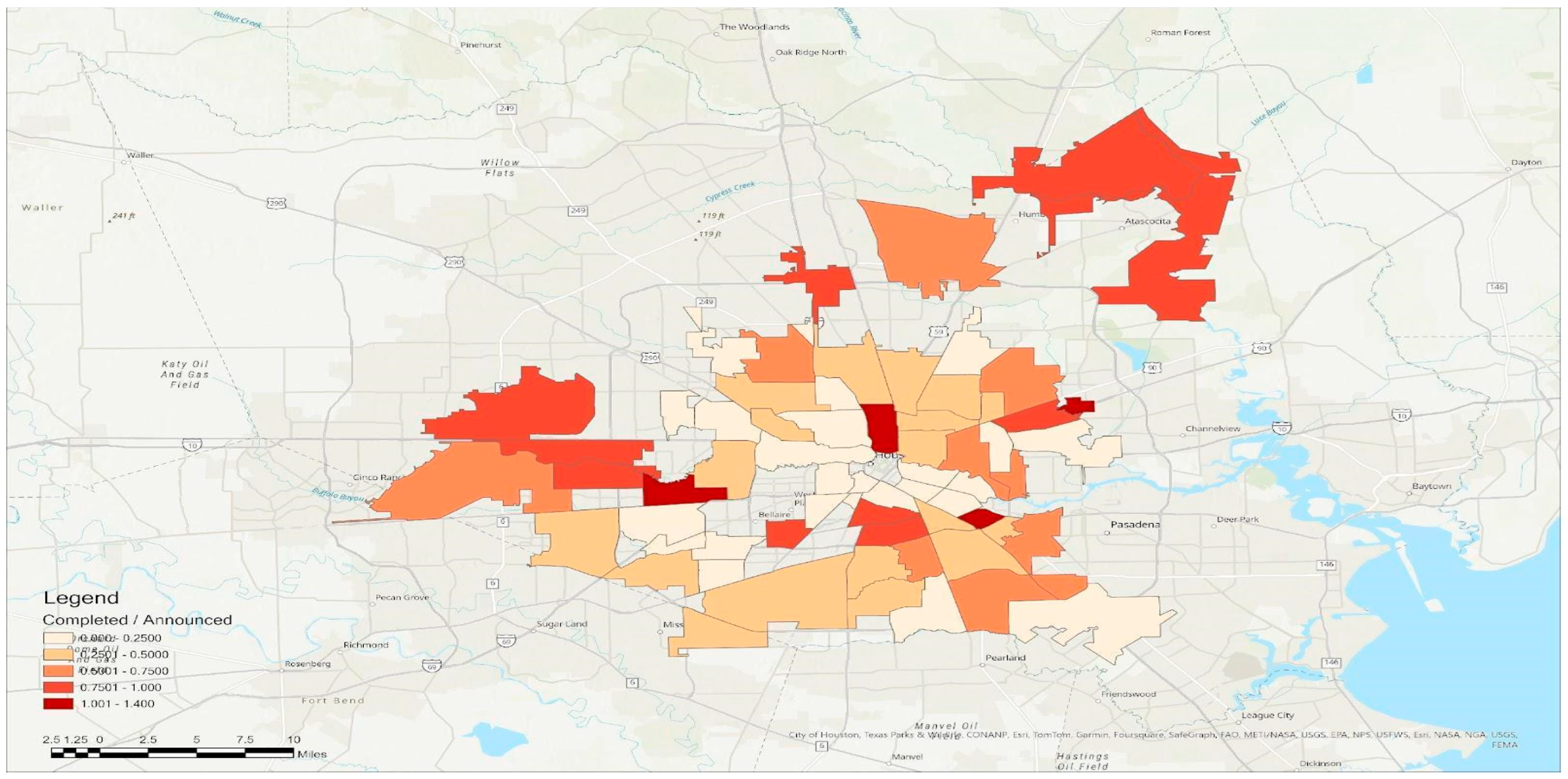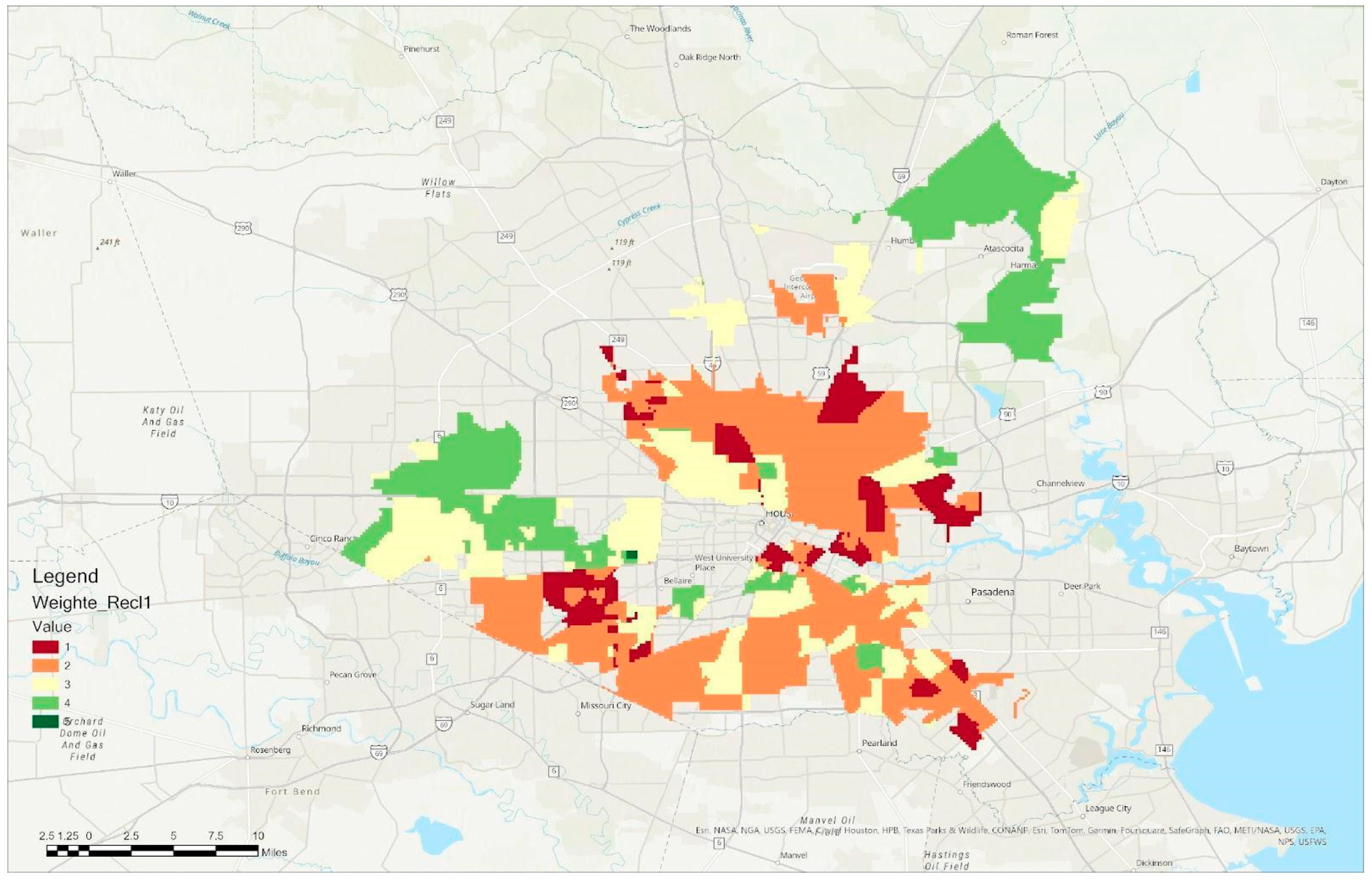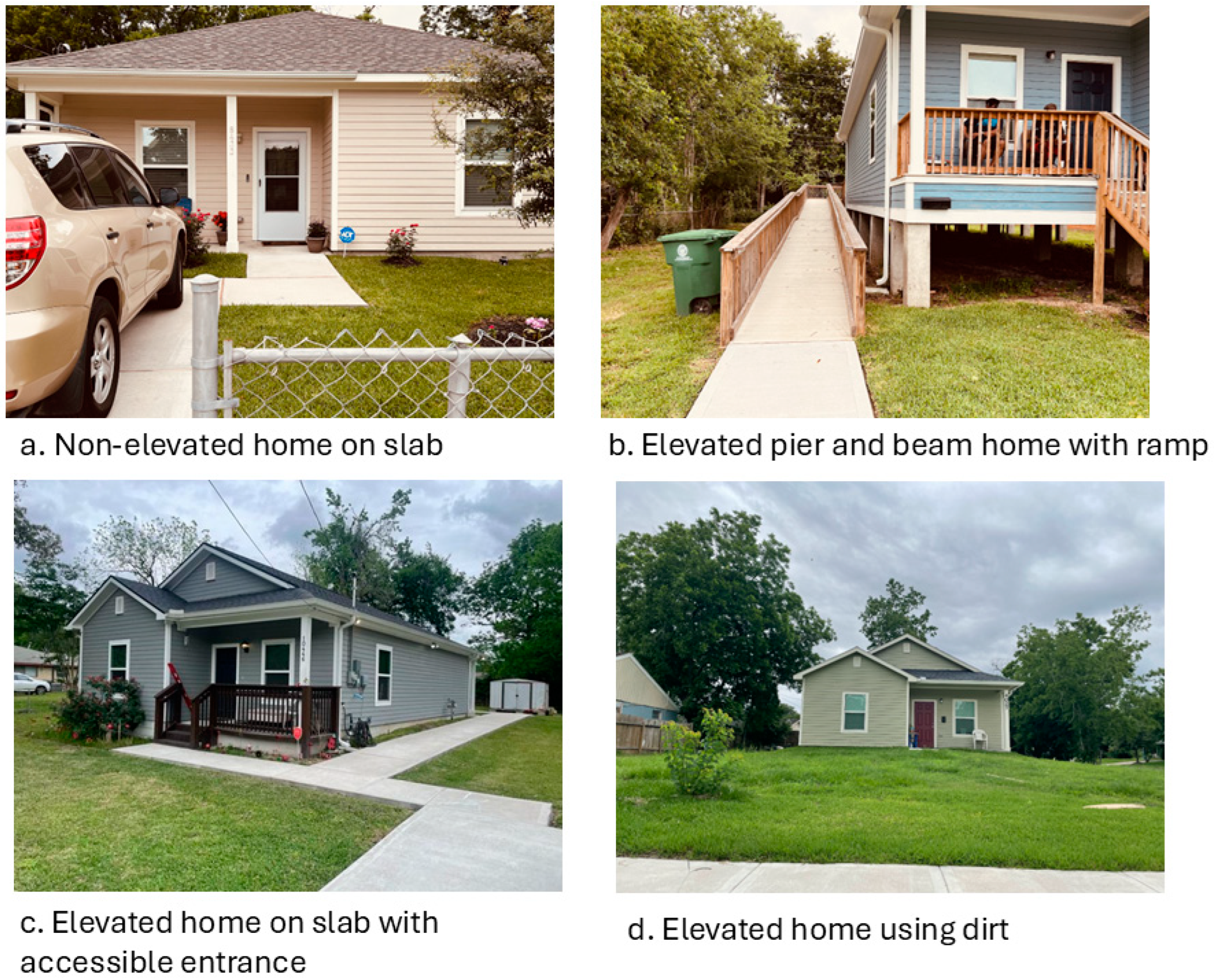1. Introduction
Hurricane Harvey made landfall on 25 August 2017, bringing unprecedented rainfall and catastrophic flooding to Houston and the surrounding region. As one of the costliest natural disasters in U.S. history, Harvey caused widespread damage, displacing thousands of residents and affecting over 300,000 structures. Houston’s vulnerability to flooding is largely due to its low-lying topography, rapid urban development, and proximity to the Gulf of Mexico/America. The city’s extensive bayou system, which historically managed stormwater, has been strained by increasing impermeable surfaces and inadequate drainage infrastructure, exacerbating flood risks. These geographic and environmental factors make Houston an essential case study for understanding flood resilience and home elevation policies.
Disasters do not impact all communities equally, and Hurricane Harvey exposed stark disparities in recovery outcomes. Low-income and historically marginalized communities often lack the financial resources, political influence, and infrastructure necessary for effective disaster mitigation. These communities are more likely to be located in flood-prone areas and to experience barriers in accessing government assistance. Addressing these inequalities requires targeted policies that not only provide financial aid but also ensure equitable access to home elevation and reconstruction programs.
In response to Harvey, federal, state, and local agencies implemented home elevation policies to reduce future flood risk. Two major programs—the City of Houston’s Homeowner Assistance Program (HoAP) and the Texas General Land Office’s (GLO) Homeowner Assistance Program (HAP)—were established to support home repair, reconstruction, and elevation. These programs were intended to increase flood resilience by elevating homes in flood-prone areas, yet disparities in program participation and completion rates persist. This raises critical questions about the factors influencing homeowners’ decisions to elevate their homes and the extent to which these programs are effectively reaching vulnerable populations. This research addresses four key research questions:
How does the demographic makeup of Houston correlate with disaster vulnerability?
Which social, personal, and demographic factors influence home elevation among participants in home repair programs?
What are the practical considerations and perceptions of flood risks that influence homeowners’ decisions to elevate their homes?
Despite growing research on climate adaptation and disaster mitigation, relatively little attention has been paid to structured home elevation programs within government-funded post-disaster recovery efforts. While studies have examined large-scale flood mitigation strategies and individual homeowner resilience, there is a gap in understanding regarding how elevation programs function in practice, particularly in urban environments like Houston. This research fills that gap by analyzing how homeowners navigate these programs, assess risks, and make elevation decisions.
To explore these issues, we employed a mixed-methods approach, combining surveys and semi-structured interviews with 50 homeowners who participated in home repair programs. Additionally, 25 undergraduate students from Texas A&M University visited affected neighborhoods, engaging with residents, and asked questions of two elevation experts in a recorded lecture discussion.
The findings indicate that home repair completion rates were lower in socially vulnerable neighborhoods, highlighting disparities in program accessibility and implementation. Among the surveyed homeowners, 70.27% of those aged 60–79 opted for home elevation, particularly in frequently flooded areas. Key factors influencing elevation decisions included accessibility concerns, neighborhood esthetics, and perceptions of elevation effectiveness. While some residents viewed elevation as a crucial mitigation strategy, others were hesitant due to financial constraints, skepticism about structural integrity, or concerns over the visual impact on their neighborhood.
This study contributes to the broader discourse on climate adaptation, disaster recovery, and housing resilience by identifying policy gaps in home elevation assistance programs. It underscores the need for more tailored outreach and equitable distribution of resources to flood-prone communities. While limited in scope, this research serves as a pilot study to support future investigations into the intersection of social vulnerability and housing adaptation. These findings provide valuable insights for policymakers, planners, and scholars working to improve disaster mitigation strategies. Additionally, this study demonstrates the value of integrating student learning into community-based research, offering a model for applied, transdisciplinary engagement in urban planning and disaster resilience studies.
1.1. Literature Review
Houston’s demographic composition is highly diverse, with significant Hispanic, African American, and immigrant populations. Many of these communities reside in economically disadvantaged neighborhoods that lack adequate infrastructure and resources, making them more vulnerable to disasters. Socioeconomic disparities, language barriers, and limited access to healthcare and transportation contribute to unequal disaster preparedness, responses, and recovery efforts [
1].
Research shows that low-income neighborhoods in Houston tend to be located at lower elevations, making them more susceptible to flooding. Even when accounting for latitude, longitude, and population density, these communities experience a higher flood risk due to historical patterns of development and disinvestment [
2]. Using Google Maps and American Community Survey data, Lu (2017) found that lower median household incomes, higher poverty rates, and a greater percentage of ethnic minorities and non-citizens were correlated with lower neighborhood elevations [
2]. This spatial inequality is not unique to Houston; similar trends are observed in other major U.S. metropolitan areas, revealing a broader pattern of environmental injustice that disproportionately exposes marginalized communities to flood hazards.
Zahran et al. (2008) further established that socially vulnerable populations in Eastern Texas suffered higher casualty rates during floods [
3]. Their study highlights that while mitigation efforts can reduce risk, socioeconomic factors significantly influence survival outcomes. Communities with greater resources and political capital tend to recover faster, while low-income residents often struggle to access disaster aid and rebuilding programs.
International studies have examined individual decision-making in flood risk mitigation, particularly in relation to home elevation. Grothmann and Reusswig (2006) found that in Germany, personal risk perception and belief in the effectiveness of mitigation measures were key drivers behind decisions to elevate homes or implement flood-resistant modifications [
4]. In France, Poussin et al. (2014) combined survey and preference data to analyze flood mitigation adoption rates, revealing that households were more likely to take action when they perceived a direct benefit [
5].
Botzen et al. (2013) studied homeowners in the Netherlands and found that 52% were willing to invest USD 10,000 in elevation measures to protect their properties [
6]. Their findings also suggest that homeowners prefer physical flood protections over financial mechanisms such as insurance, emphasizing a willingness to pay for certainty in risk reduction.
While these studies provide insights into flood mitigation behaviors globally, they do not address homeowners already enrolled in a structured reconstruction program with elevation options. Understanding these decision-making processes within government-backed programs is crucial in designing effective disaster resilience policies.
Previous research has highlighted the importance of federal and local mitigation grants in making home elevation financially feasible [
7]. Programs such as FEMA’s Hazard Mitigation Grant Program (HMGP), Flood Mitigation Assistance Program (FMA), and Pre-Disaster Mitigation Grant Program (PDM) provide funding to help homeowners elevate their properties. However, access to these funds is often inequitable, with low-income homeowners facing bureaucratic barriers, a lack of information, and financial limitations that prevent them from fully utilizing the available resources [
8,
9].
The Homeowner Assistance Program (HAP) in Houston is an example of a large-scale government initiative aimed at flood resilience. However, disparities in program outcomes suggest the inequitable distribution of resources, with some communities benefiting more than others. This study investigates how program participants perceive and navigate home elevation decisions, contributing to a deeper understanding of the barriers and incentives within structured recovery programs.
Flooding in Houston is a combined result of natural vulnerability and urban development patterns. The city’s flat coastal geography and proximity to the Gulf of Mexico inherently expose it to high flood risks [
10]. However, the rapid urban expansion since the mid-20th century has exacerbated these risks, with unchecked development reducing the natural drainage capacity and straining the existing infrastructure [
11].
Hurricane Harvey (25 August–3 September 2017) serves as a landmark event in Houston’s flood history. The storm dumped an estimated 27 trillion gallons of rain over Texas, leading to catastrophic flooding that damaged over 300,000 structures and displaced more than 30,000 residents in Houston alone [
12]. The economic damages reached approximately USD 125 billion, making Harvey one of the costliest disasters in U.S. history [
13].
The aftermath of Harvey exposed systemic weaknesses in Houston’s flood management policies. Many affected residents struggled to access assistance programs, while outdated floodplain maps and inconsistent building regulations failed to prevent new construction in high-risk areas [
14]. Although FEMA and the Texas General Land Office have since revised floodplain designations and elevation requirements, the effectiveness of these changes remains a subject of ongoing debate.
Houston’s floodplains are mapped by FEMA, and these maps are updated regularly to reflect changes in topography, hydrology, and urban development. However, the fast-changing nature of land use, climate, and storm patterns means that these maps can quickly become outdated, making flood risk assessment and management challenging. The discrepancies in mapped versus actual flood risks create uncertainty for homeowners when deciding whether to elevate their homes or take other protective measures.
1.2. Research Gap
While numerous studies have explored flood risk perception and mitigation strategies, there is limited research on how homeowners make elevation decisions within structured reconstruction programs. By examining Houston’s Homeowner Assistance Program (HoAP) and Texas General Land Office’s Homeowner Assistance Program (HAP), this study contributes to the broader discourse on climate adaptation, social vulnerability, and disaster resilience planning. Understanding who chooses to elevate, why, and what challenges they face is essential in designing equitable and effective housing recovery programs in flood-prone communities.
2. Materials and Methods
2.1. Study Site and Access
Houston, Texas, exemplifies the tension between rapid urban expansion and vulnerability to natural hazards, particularly flooding. The city’s geographic and topographic features, combined with rapid development and inadequate drainage infrastructure, have exacerbated its susceptibility to severe flood events. For this study, we purposefully selected Houston due to its frequent flooding, its diverse population, and the availability of structured home repair and elevation assistance programs following Hurricane Harvey.
Our research focused on participants in home repair programs targeting flood-prone neighborhoods. These communities are characterized by socioeconomic disparities, a mix of long-term residents and transient populations, and varying degrees of flood risk awareness. The diverse social and economic conditions in these neighborhoods influence residents’ access to recovery programs and their decision-making processes regarding home elevation.
To facilitate community engagement and research participation, we partnered with Texas Housers, a nonprofit advocating for housing justice and disaster recovery for low-income households. Their established relationships within these neighborhoods helped build trust with residents, many of whom were initially hesitant to participate in research activities. Texas Housers also assisted in identifying and recruiting program participants, ensuring that the study reflected the perspectives of those most affected by flood-related displacement and home repair challenges.
2.2. Data Collection
2.2.1. Field Trip
As part of this study, 25 undergraduate students from Texas A&M University’s Urban and Regional Studies Capstone Course, accompanied by two faculty members, conducted a structured field trip to one of the thirteen flood-affected neighborhoods. Neighborhoods were selected based on their proximity to flood-prone bayous and high concentrations of homes eligible for elevation programs. During this one day, 8 to 10 h field trip on 29 February 2024, students engaged in direct observations of flood-damaged homes and elevated structures. They also engaged in informal conversations (not recorded) with seven homeowners about their flood experiences and perspectives on home elevation. (Faculty members formally interviewed these participants). Faculty also involved students in a recorded lecture with two elevation specialists, who provided a technical overview of elevation methods and financial considerations for affected homeowners. Students were able to ask open-ended questions.
Students also met with representatives from Texas Housers, who facilitated access to four program participants and arranged site visits to homes undergoing elevation or reconstruction. The field trip provided valuable firsthand insights into the physical, financial, and emotional challenges related to home elevation and reinforced students’ understanding of community-based research in disaster recovery planning.
2.2.2. Secondary Data Collection and Analysis
To assess the physical and social factors influencing home elevation decisions, we collected and analyzed in Geographic Information System (GIS) secondary data sources, including the following:
Flooding frequency: FEMA’s National Flood Hazard Layer (NFHL) (2024).
Topographic elevation data: LiDAR Elevation Data (DEM) from the Texas Natural Resources Information System (TNRIS) and Texas Geographic Information Office (TxGIO) (2023).
Social vulnerability indicators: CDC’s Social Vulnerability Index (2020) to evaluate the intersection of flood risk and socioeconomic conditions.
Home elevation program records: Publicly available data from the City of Houston’s HoAP program (2024), detailing the number and locations of elevated homes.
Additionally, we submitted a public record request to the Texas General Land Office (GLO) for program data related to elevation requirements, demographics of applicants, and home foundation types (slab, pier, or beam). These data were not received in time for inclusion in this report but will be analyzed in future research.
2.2.3. Survey and Interviews
To explore homeowners’ perceptions of home elevation, we conducted 50 surveys and in-depth interviews with participants in the City of Houston’s and Texas GLO’s home repair programs. All participants were either eligible for or had been offered home elevation assistance.
Participants were recruited from 13 neighborhoods across Houston, identified through flood impact maps and program participation records. The selected neighborhoods represented diverse geographic clusters across the north, south, east, and west of downtown Houston, capturing a range of flood experiences and recovery challenges. We visited 130 addresses; 4 people declined, and 76 people were not home or did not answer the door (we left a flyer). We were able to conduct 50 surveys/interviews. Even though the flyer included information about completing a survey online, no one did so. The participation rate was 39.7%. GLO records show that 1608 participated in the program. The sample represents approximately 3.1% of the total program participants.
Surveys were administered door-to-door, with homeowners choosing whether to complete the survey inside or outside their homes. Each visit lasted between 20 min and over an hour (most around 40 min), allowing time for in-depth discussions and site observations. Paper-based surveys measured demographic variables, flood history, decision-making factors, and perceptions of government assistance. A consent form was given to participants for them to keep for their records.
Interviews were recorded with participant consent, while detailed notes were taken for those who declined recording. A follow-up interview was conducted to validate survey responses and ensure data consistency. In addition to resident interviews, we conducted structured interviews with two elevation specialists during the field trip. These experts provided technical explanations about elevation processes and financial and regulatory challenges, offering additional context for interpreting homeowner decisions. We promised confidentiality to all participants.
2.3. Quantitative and Qualitative Data Analysis
Survey responses (N = 50) were analyzed using descriptive statistics (mean, median, and standard deviation). Chi-square tests were used to examine relationships between demographic factors (e.g., age and disability status) and home elevation decisions.
Interview transcripts were coded thematically using Dedoose web application for mixed methods research. Key themes included perceived flood risks, government assistance, mobility concerns, and neighborhood esthetics. Comparative analysis was conducted to identify common patterns across different demographic groups.
2.4. Ethical Considerations and Researcher Positionality
This study was conducted in accordance with ethical guidelines, as approved by the Institutional Review Board (IRB) (ID: STUDY2004-0011) at Texas A&M University.
Participants were informed about the study’s purpose, risks, and confidentiality protections before agreeing to participate. Participants were given a consent form for them to read and kept. Homeowners received USD 20 cash compensation for their time and were promised access to the study results. We collected the contact information of participants but de-identified the information for the data collected. All participant names were replaced with pseudonyms. Interviews and survey responses were anonymized to protect identities. Findings will be shared with participants through focus groups and follow-up presentations (in-person and via conference calls). This was designed to ensure that residents benefited from the research and could use the results to advocate for better disaster recovery policies.
4. Discussion
4.1. Synthesizing Findings: Disparities in Flood Adaptation and Policy Implications
Our findings align with existing research on flood adaptation, social vulnerability, and housing policy, reaffirming that disaster mitigation efforts must be tailored to the needs of socioeconomically disadvantaged communities. Prior studies have demonstrated that homeowners’ decisions to elevate their homes are influenced by financial constraints, risk perception, and access to government assistance [
1,
6]. Our study highlights the multifaceted nature of home elevation decisions and the broader implications for flood adaptation and disaster recovery. While financial incentives and risk awareness are crucial motivators, social vulnerability, accessibility concerns, and neighborhood esthetics significantly influence homeowners’ decisions. These findings underscore the fact that policy interventions must extend beyond financial support to address structural inequities in program implementation.
Disparities in home elevation completion rates reflect broader patterns of inequitable disaster recovery. The spatial analysis reveals that socially vulnerable communities, particularly those with higher proportions of minority and low-income residents, have lower completion rates for home elevation projects. This suggests that systemic barriers—such as bureaucratic complexity, lack of information, and historical disinvestment—continue to impede equitable access to resilience-building measures. While wealthier communities tend to retain existing housing structures with minor modifications, low-income neighborhoods experience more extensive demolitions and rebuilds, further exacerbating displacement and long-term housing insecurity.
Our findings align with previous research on the challenges faced by low-income communities in accessing disaster mitigation funding. Despite the availability of home elevation assistance, program uptake remains uneven, particularly among homeowners with disabilities and those uncertain about their flood risk. A significant proportion of surveyed homeowners were unaware of their flood zone status, pointing to deficiencies in public communication and outreach efforts. Addressing these gaps requires a more proactive, community-centered approach to disaster preparedness and risk mitigation.
4.2. Practical Considerations and Homeowner Decision-Making
Beyond financial and policy-related factors, homeowners’ perceptions of home elevation effectiveness vary widely. While many see elevation as a long-term flood protection strategy, others remain skeptical due to concerns about structural integrity, maintenance costs, and neighborhood esthetics. These perceptions influence program participation rates and highlight the need for clearer public messaging on the benefits and trade-offs of home elevation.
The findings also reveal important insights into mobility and accessibility concerns. While ramps and accessibility modifications are available, they are not always practical or desirable for homeowners, particularly in communities where esthetic cohesion is highly valued. Older homeowners, who make up a significant portion of those opting for elevation, often cite past flooding experiences as a primary motivator. Conversely, individuals with disabilities report hesitations due to the logistical challenges of accessing elevated homes. This suggests that current elevation programs may need to incorporate more flexible, adaptive solutions tailored to diverse household needs.
4.3. Policy Recommendations and Future Research Directions
Many homeowners remain uncertain about their flood risk status and available mitigation options. More effective communication strategies, including targeted community engagement and multilingual resources, are needed to ensure that residents can make informed decisions.
While elevation can provide crucial flood protection, accessibility remains a major barrier for individuals with disabilities. Future programs should integrate more inclusive design features and offer financial support for adaptive modifications beyond traditional ramps.
The lower completion rates in socially vulnerable neighborhoods suggest systemic inequities in program implementation. Streamlining application processes, reducing bureaucratic hurdles, and providing targeted support for historically marginalized communities can enhance accessibility and participation.
While elevation is a widely recommended flood mitigation strategy, its long-term effectiveness in different socio-economic and environmental contexts remains uncertain. Future research should examine post-elevation outcomes, including maintenance challenges, changes in property values, and shifts in community demographics.
Given the clear disparities in program outcomes, home elevation initiatives should be embedded within broader environmental justice frameworks. Policies should prioritize vulnerable communities, ensuring equitable access to flood protection resources and minimizing displacement risks.
4.4. Limitations and Opportunities for Further Study
While this study provides valuable insights, it is limited in scope and sample size. A larger dataset encompassing a wider geographic area would enhance the generalizability of findings. Additionally, future research should incorporate longitudinal analyses to track changes in home elevation adoption and effectiveness over time. Comparative studies across different cities and regions could further illuminate best practices for equitable disaster recovery and climate adaptation.
5. Conclusions
This study has underscored the complex interplay between social vulnerability, housing policy, and flood adaptation in post-disaster recovery. While home elevation programs offer critical flood mitigation opportunities, their effectiveness is constrained by systemic inequities in program implementation, accessibility, and homeowner perceptions. Older homeowners are more likely to elevate their homes, whereas individuals with disabilities face additional barriers, pointing to the need for more adaptive, inclusive solutions.
Beyond its immediate policy implications, this research contributes to broader discussions on climate resilience, disaster recovery, and equitable urban planning. Addressing disparities in home elevation outcomes requires a holistic approach that integrates financial assistance, targeted outreach, and accessibility considerations. By centering the needs of historically marginalized communities, policymakers and practitioners can develop more effective and equitable flood mitigation strategies that enhance long-term resilience for all homeowners.
